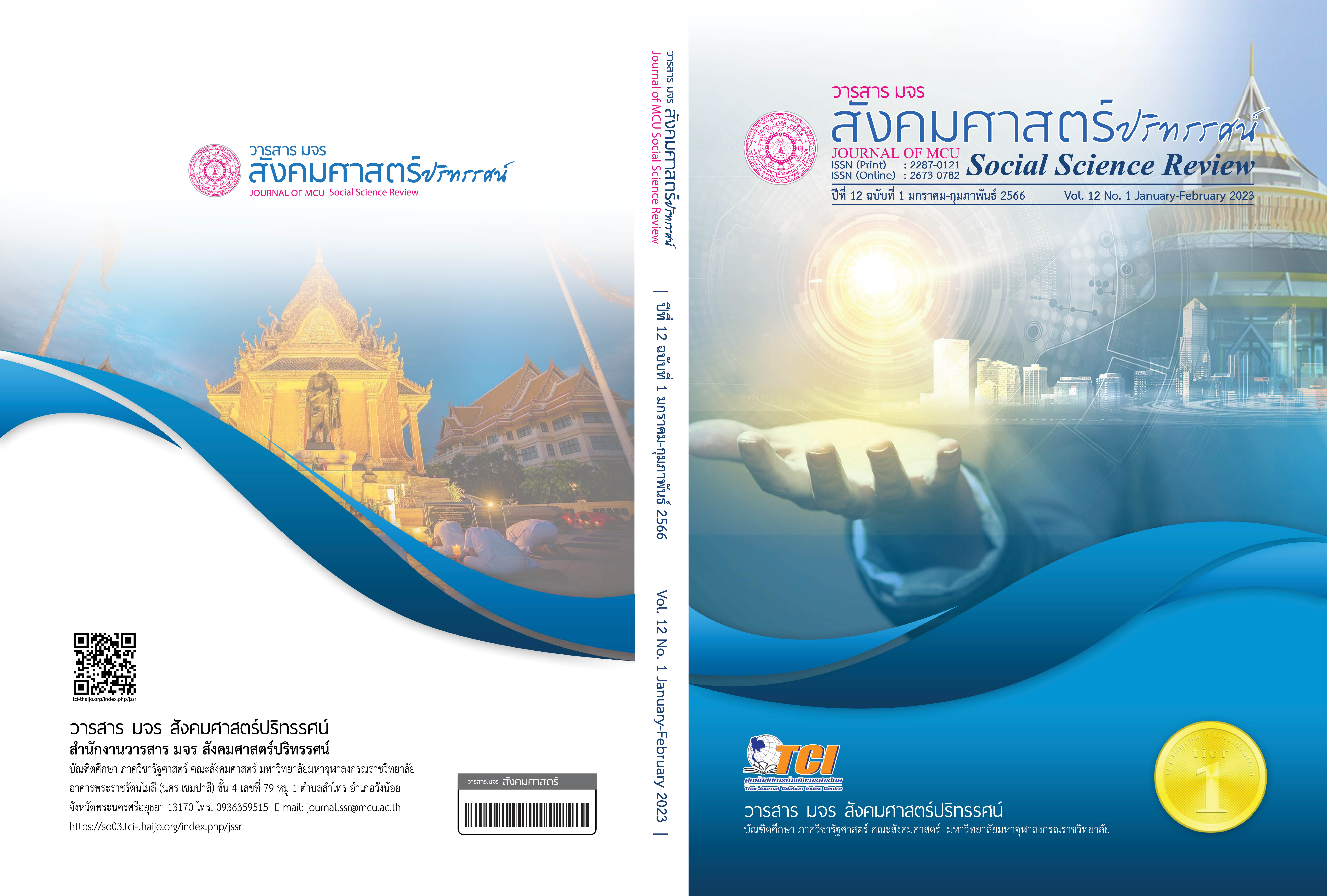การปฏิบัติใช้มรรคมีองค์ 8 เพื่อเพิ่มสรรมถนะทุนมนุษย์
คำสำคัญ:
มรรค 8, สมรรถนะ, ทุนมนุษย์, การปฏิวัติอุตสาหกรรมบทคัดย่อ
งานวิจัยฉบับนี้มีวัตถุประสงค์เพื่อศึกษาวิธีการนำหลักมรรคมีองค์ 8 มาประยุกต์ใช้ในองค์กรธุรกิจของไทยในยุคอุตสาหกรรม 4.0 รวมถึงปัจจัยต่าง ๆ ที่มีผลกระทบต่อการนำหลักมรรคมีองค์ 8 มาใช้ และผลสำเร็จจากการนำหลักมรรคมีองค์ 8 มาใช้โดยมุ่งศึกษาในกลุ่มองค์กรธรุกิจขนาดเล็กในภาคอุตสาหกรรม โดยใช้วิธีการวิจัยแบบผสานวิธี การวิจัยเชิงปริมาณเก็บข้อมูลจากกลุ่มตัวอย่าง 309 คน จาก 5 บริษัทในภาคอุตสาหกรรม โดยใช้แบบสอบถาม การวิจัยเชิงคุณภาพใช้การรวบรวมข้อมูลจาการสัมภาษณ์เชิงลึกกับผู้เชี่ยวชาญ 16 ท่าน และการสนทนากลุ่มกับผู้ทรงคุณวุฒิ ด้านต่าง ๆ 10 ท่าน
ผลการวิจัยพบว่าองค์กรทั้ง 5 มีและใช้กิจกรรมการพัฒนาทรัพยากรมนุษย์ต่าง ๆ ในองค์กรอย่างสม่ำเสมออยู่แล้วและนำหลักมรรคมีองค์ 8 มาประยุกต์ใช้เพื่อเสริมให้สามารถพัฒนาสมรรถนะทุนมนุษย์ให้ได้ดียิ่งขึ้นผ่านเครื่องมือต่าง ๆ 4 ชนิดคือ (1) กฎระเบียบของบริษัท (2) วัฒนธรรมองค์กร (3) กิจกรรมการสวดมนต์ และ (4) กิจกรรมสันทนาการอื่น ๆ ปัจจัยที่มีผลต่อการนำหลักมรรคมีองค์ 8 มาใช้ได้แก่ความมุ่งมั่นและความร่วมมือของเจ้าของกิจการและทีมงาน ผลการวิจัยพบว่าการนำหลักมรรคมีองค์ 8 มาใช้สามารถช่วยเพิ่มสมรรถนะทุนมนุษย์ในองค์กรได้
เอกสารอ้างอิง
Gnanaloka, V. M. (2019). The Noble Eight-fold Path as Mundane Path and as a Constituent of Supramundane Path (Research Paper). Sri Lanka: The 5th International Buddhist Conference.
Mcclelland, D. C. (1974). Testing for competence rather than for Intelligence. USA: American Psychologist.
Nadler, L. & Nadler, Z. (1991). Developing Human Resources (3rd Edition). San Francisco: Jossey-Bass.
Phra Brahmagunabhorn. (2007). Some Basic Concepts of Buddhism. in Phra Brahmagunabhorn Vision of the Dhamma, A Collection of Buddhist Writings in English. Thailand: Wat Nyanavesakavan.
______. (2019). Education Dictionary of Buddhism Vols. 34. Thailand: The Foundation of Peace.
Phrarajbhavanavisudh. (2007). Tomorrow the World Will Change. Thailand: Tawandhamma Foundation.
Spencer, L. M. & Spencer, S. M. (1993). Competence at Work: Models for Superior Performance. Canada: John Wiley & Son, Inc.
Werner, J M. & DeSimone, R L. (2012). Human Resource Development (6th Edition). USA: South-Western
Warrell, M. (2014). Learn Unlearn And Relearn: How To Stay Current And Get Ahead. Retrieved January 30, 2020, from https://www.forbes.com/.
ดาวน์โหลด
เผยแพร่แล้ว
รูปแบบการอ้างอิง
ฉบับ
ประเภทบทความ
สัญญาอนุญาต
ลิขสิทธิ์ (c) 2023 วารสาร มจร สังคมศาสตร์ปริทรรศน์

อนุญาตภายใต้เงื่อนไข Creative Commons Attribution-NonCommercial-NoDerivatives 4.0 International License.
เพื่อให้เป็นไปตามกฎหมายลิขสิทธิ์ ผู้นิพนธ์ทุกท่านต้องลงลายมือชื่อในแบบฟอร์มใบมอบลิขสิทธิ์บทความให้แก่วารสารฯ พร้อมกับบทความต้นฉบับที่ได้แก้ไขครั้งสุดท้าย นอกจากนี้ ผู้นิพนธ์ทุกท่านต้องยืนยันว่าบทความต้นฉบับที่ส่งมาตีพิมพ์นั้น ได้ส่งมาตีพิมพ์เฉพาะในวารสาร มจร สังคมศาสตร์ปริทรรศน์ เพียงแห่งเดียวเท่านั้น หากมีการใช้ภาพหรือตารางหรือเนื้อหาอื่นๆ ของผู้นิพนธ์อื่นที่ปรากฏในสิ่งตีพิมพ์อื่นมาแล้ว ผู้นิพนธ์ต้องขออนุญาตเจ้าของลิขสิทธิ์ก่อน พร้อมทั้งแสดงหนังสือที่ได้รับการยินยอมต่อบรรณาธิการ ก่อนที่บทความจะได้รับการตีพิมพ์ หากไม่เป็นไปตามข้อกำหนดเบื้องต้น ทางวารสารจะถอดบทความของท่านออกโดยไม่มีข้อยกเว้นใดๆ ทั้งสิ้น





